- This topic has 3 replies, 1 voice, and was last updated 2 years, 11 months ago by
Hamid.
-
CreatorTopic
-
2021-08-03 at 11:08 am #891
Sharan reddy
How to connect common mode voltage source of induction motor with bearing equivalent model for simulation studies and motor equivalent parameters.
How to connect common mode voltage source of induction motor with bearing equivalent model for simulation studies and motor equivalent parameters.
please help me. -
CreatorTopic
-
AuthorReplies
-
2021-08-03 at 11:08 am #2889
Hamid
Alger investigated shaft and bearing currents in the 1920’s. Exciting the induction motor with sine waves provided a reference condition. Measurements of the stator neutral to ground and rotor to ground voltages and rotor current were made while operating the induction machine at no-load and 60 Hz. The results of those tests are shown in Figure below. EDM currents were not detected. The 60 volt stator neutral voltage induced a 1 volt rotor voltage, a 60 to 1 reduction. This rotor shaft voltage level is at the upper end of the standards.
 Figure below shows the physical construction of the test motor. Both the drive and non drive ends of the rotor were outfitted with an insulated bearing support sleeve, which isolated the rotor bearings from the motor frame. This provided a measurement of the rotor open circuit voltage, and when shorted by the grounding strap, simulates an actual bearing mounting. In addition, the grounding strap provides a mechanism for measuring the bearing to ground current. Figure shows a carbon brush for measuring the rotor voltage and investigating solutions to the EDM bearing current problem. The motor had 48 stator slots and 64 rotor bars.
Figure below shows the physical construction of the test motor. Both the drive and non drive ends of the rotor were outfitted with an insulated bearing support sleeve, which isolated the rotor bearings from the motor frame. This provided a measurement of the rotor open circuit voltage, and when shorted by the grounding strap, simulates an actual bearing mounting. In addition, the grounding strap provides a mechanism for measuring the bearing to ground current. Figure shows a carbon brush for measuring the rotor voltage and investigating solutions to the EDM bearing current problem. The motor had 48 stator slots and 64 rotor bars. 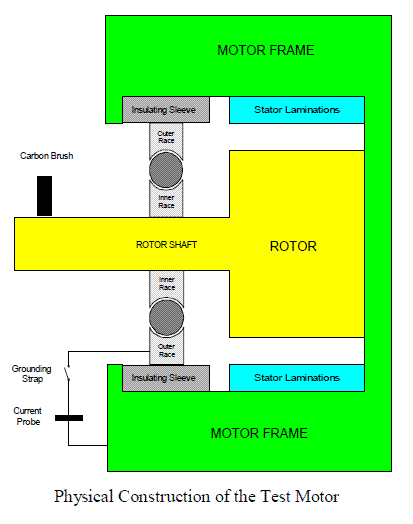 Figure below depicts the capacitive coupling relevant to the development of the model. The stator to frame capacitance (Csf) is a distributed element representing the capacitive coupling to frame along the length of the stator conductors. For most investigations, magnetic coupling of the stator and rotor is sufficient. But with the high dv/dt present with modern power devices, capacitive coupling considerations cannot be ignored. Therefore, the stator to rotor capacitance (Csr) and the rotor to frame capacitance (Crf) are included.
Figure below depicts the capacitive coupling relevant to the development of the model. The stator to frame capacitance (Csf) is a distributed element representing the capacitive coupling to frame along the length of the stator conductors. For most investigations, magnetic coupling of the stator and rotor is sufficient. But with the high dv/dt present with modern power devices, capacitive coupling considerations cannot be ignored. Therefore, the stator to rotor capacitance (Csr) and the rotor to frame capacitance (Crf) are included. 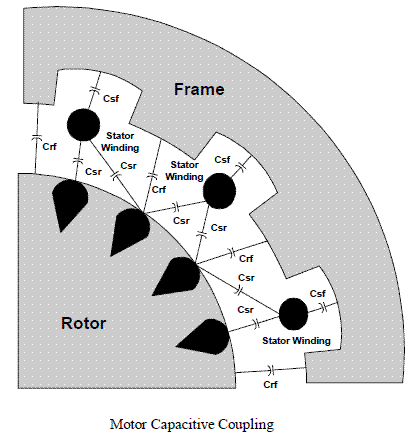 The bearings, lubricating film, and insulating sleeve present a combination of capacitances, resistances, and a nonlinear impedance, Figure below.
The bearings, lubricating film, and insulating sleeve present a combination of capacitances, resistances, and a nonlinear impedance, Figure below. 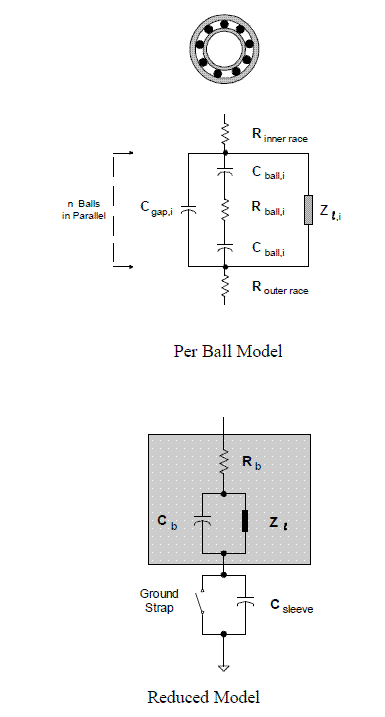 First there exists an inner and outer race resistance. Then, depending on the physical construction, the bearing consists of n balls in parallel; each ball having an effective resistance (Rball,i). In addition, each ball is immersed in the lubricating film; thus, each ball develops two capacitances (Cball,i) linking the ball to the inner and outer races. The ball portion of the bearing model, therefore, consists of n parallel combinations of (Cball,i) and (Rball,i). Between balls, the inner and outer races are separated by the lubricant, which forms a dielectric barrier. Therefore, a capacitance (Cgap,i) is formed between each pair of balls, resulting in n parallel capacitors. The nonlinear impedance (Zl,i) accounts for the mechanical and electrical abnormalities and randomness of the bearing. Combining the individual components results in a reduced order bearing model, which is compatible with the motor drive models employed in simulations and analyses. The reduced order model consists of a resistance (Rb) in series with the parallel combination of an effective capacitance (Cb) and a nonlinear impedance (Zl). Finally, the insulating sleeve adds a series capacitance (Csleeve) that is shorted when the grounding strap is employed. For exampel combining the bearing model with a simple inverter/motor model yields the model of Figure below. Here, the inverter is modeled as three line to neutral voltages with a neutral to ground zero sequence source. This model allows the inverter’s voltages to be examined as positive, negative, and zero sequence sets. The motor is represented as two sets of three phase windings; one each for the stator and rotor windings. The capacitive coupling from stator to frame is lumped at the neutral of the stator winding and the capacitive coupling between the stator and rotor connects the stator and rotor zero sequence networks. Finally, the rotor to frame capacitance and bearing provide the paths to ground from the rotor shaft, here represented by the neutral of the rotor.
First there exists an inner and outer race resistance. Then, depending on the physical construction, the bearing consists of n balls in parallel; each ball having an effective resistance (Rball,i). In addition, each ball is immersed in the lubricating film; thus, each ball develops two capacitances (Cball,i) linking the ball to the inner and outer races. The ball portion of the bearing model, therefore, consists of n parallel combinations of (Cball,i) and (Rball,i). Between balls, the inner and outer races are separated by the lubricant, which forms a dielectric barrier. Therefore, a capacitance (Cgap,i) is formed between each pair of balls, resulting in n parallel capacitors. The nonlinear impedance (Zl,i) accounts for the mechanical and electrical abnormalities and randomness of the bearing. Combining the individual components results in a reduced order bearing model, which is compatible with the motor drive models employed in simulations and analyses. The reduced order model consists of a resistance (Rb) in series with the parallel combination of an effective capacitance (Cb) and a nonlinear impedance (Zl). Finally, the insulating sleeve adds a series capacitance (Csleeve) that is shorted when the grounding strap is employed. For exampel combining the bearing model with a simple inverter/motor model yields the model of Figure below. Here, the inverter is modeled as three line to neutral voltages with a neutral to ground zero sequence source. This model allows the inverter’s voltages to be examined as positive, negative, and zero sequence sets. The motor is represented as two sets of three phase windings; one each for the stator and rotor windings. The capacitive coupling from stator to frame is lumped at the neutral of the stator winding and the capacitive coupling between the stator and rotor connects the stator and rotor zero sequence networks. Finally, the rotor to frame capacitance and bearing provide the paths to ground from the rotor shaft, here represented by the neutral of the rotor.  Reference: Effect of PWM Inverters on AC Motor Bearing Currents and Shaft Voltages Jay Erdman, Russel J. Kerkman, Dave Schlegel, and Gary Skibinski2021-08-03 at 11:08 am #2890
Reference: Effect of PWM Inverters on AC Motor Bearing Currents and Shaft Voltages Jay Erdman, Russel J. Kerkman, Dave Schlegel, and Gary Skibinski2021-08-03 at 11:08 am #2890Sharana reddy
thank you for responding to my request,actually what values ofstator and rotor parameter to be considered for simulation studies in the inverter/motor model,please suggest me. thanking you sir
2021-08-03 at 11:08 am #2891Hamid
Referring to mentioned reference, the calculations and tests provided parameter values and the source voltage. To calculate the stator to rotor capacitance, two parallel conductors were analyzed with a separation equal to the distance between the centers of the conductors. This value was modified to reflect the number of stator slots and slot opening area. To establish the rotor to frame capacitance, the rotor and stator were considered to be parallel cylinders with an air gap. Figure below shows the Crf as a function of horsepower for 4 and 6 pole motors. The bearing film capacitance was calculated assuming a spherical construction for the ball with respect to the race surface.
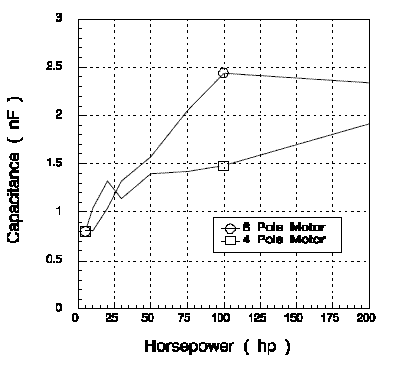 A typical value for the ball bearing capacitance is 190 pF. The calculated values for the test motor and bearing are contained in Table below.
A typical value for the ball bearing capacitance is 190 pF. The calculated values for the test motor and bearing are contained in Table below.  Tests were performed to establish the accuracy of the above calculations. With the stator unexcited and the rotor coupled to a drive motor, measurements of the effective capacitance from rotor to frame were made with a RLC meter at various speeds. The tests consistently produced a capacitance of 1400 pF. This value represents the equivalent of Csr // ( Csf + (Crf //Cb)). Although the Cb depends on the speed of rotation, the invariance of the measurement suggests Crf dominates. The Csf is obtained by measuring the capacitance from the stator terminals to frame with the rotor removed. To establish the Csr, measurements were made of the effective capacitance from stator terminals to frame with rotor shaft and frame connected. The Csr is obtained by subtracting Csf . Figure below shows Csr for the test motor as a function of frequency.
Tests were performed to establish the accuracy of the above calculations. With the stator unexcited and the rotor coupled to a drive motor, measurements of the effective capacitance from rotor to frame were made with a RLC meter at various speeds. The tests consistently produced a capacitance of 1400 pF. This value represents the equivalent of Csr // ( Csf + (Crf //Cb)). Although the Cb depends on the speed of rotation, the invariance of the measurement suggests Crf dominates. The Csf is obtained by measuring the capacitance from the stator terminals to frame with the rotor removed. To establish the Csr, measurements were made of the effective capacitance from stator terminals to frame with rotor shaft and frame connected. The Csr is obtained by subtracting Csf . Figure below shows Csr for the test motor as a function of frequency. 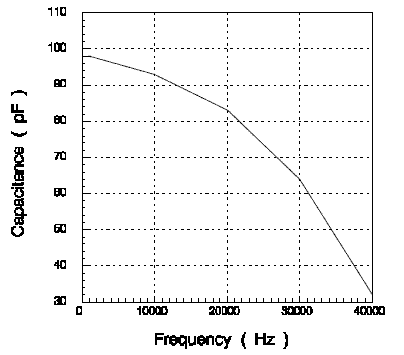 Finally, the bearing impedance Zl was measured as a function of rotational speed, the results of which are shown in Figure below.
Finally, the bearing impedance Zl was measured as a function of rotational speed, the results of which are shown in Figure below. 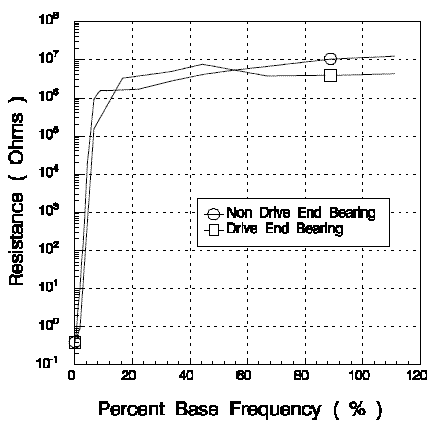 This in combination with the measured value of Cb allowed for the determination of Crf . The measured values are included in mentioned Table. Verification of the parameter values consisted of tests with the insulating sleeve grounding strap open circuited and the drive operating at various frequencies at no-load. The stator neutral to ground voltage and rotor voltage to ground were measured; the stator voltage from the neutral of the stator windings and the rotor voltage from the rotor brush attachment. Typical results of the tests are displayed in Figure below.
This in combination with the measured value of Cb allowed for the determination of Crf . The measured values are included in mentioned Table. Verification of the parameter values consisted of tests with the insulating sleeve grounding strap open circuited and the drive operating at various frequencies at no-load. The stator neutral to ground voltage and rotor voltage to ground were measured; the stator voltage from the neutral of the stator windings and the rotor voltage from the rotor brush attachment. Typical results of the tests are displayed in Figure below. 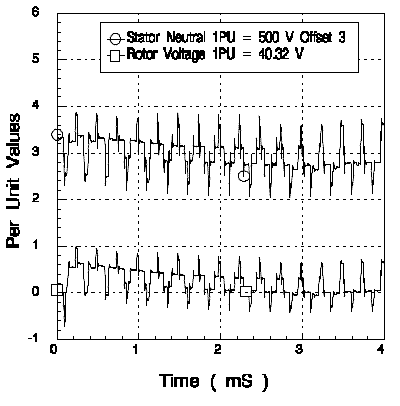
-
AuthorReplies
- You must be logged in to reply to this topic.
